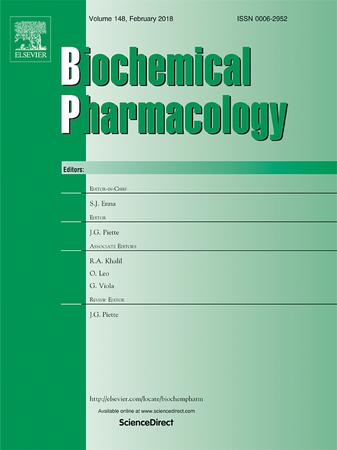对 UCP1162 进行评估,它是一种有效的二氢叶酸还原酶丙炔链抑制剂,有望应用于癌症和自身免疫性疾病。
IF 5.3
2区 医学
Q1 PHARMACOLOGY & PHARMACY
引用次数: 0
摘要
细胞抗药性会限制抗叶酸药物治疗癌症和自身免疫性疾病的效果。在这里,我们研究了一种丙炔基连接的非经典抗叶酸药 UCP1162 的生化和细胞效应,这种药在甲氨蝶呤耐药性背景下显示出卓越的效力和复原力。UCP1162 可抑制人类 DHFR 酶,其亲和力和动力学特性与甲氨蝶呤(MTX)相当。UCP1162 还能抑制癌细胞增殖,并在低纳摩尔浓度下与细胞 DHFR 结合。亮菌甲素抑制了 UCP1162 对细胞的作用,这与 UCP1162 作为一种抗叶酸的作用是一致的。与其他抗叶酸盐一样,UCP1162 也能减轻小鼠的急性炎症反应,抑制 FLS 细胞的生长和运动。单细胞 RNA 序列分析表明,MTX 和 UCP1162 在暴露 48 小时后会产生重叠的基因表达变化。然而,虽然可以很容易地筛选出抗 MTX 的白血病细胞(CCRF-CEM),但却无法获得抗 UCP1162 的细胞。长期暴露于 UCP1162 会导致静态培养表达干细胞基因(CD34、ABCG2、ABCB1)、适应性基因(TCN2、CDKN1A)和可能作为治疗靶点的基因(TPBG/5T4、TNFRSF10A、ACE)。这些研究结果表明,UCP1162 是研究细胞对长期抗叶酸治疗反应的一种独特工具,有望成为能够克服某些形式抗叶酸耐药性的先导化合物。本文章由计算机程序翻译,如有差异,请以英文原文为准。

Evaluation of UCP1162, a potent propargyl-linked inhibitor of dihydrofolate reductase with potential application to cancer and autoimmune disease
Cellular resistance can limit the effectiveness of antifolate drugs for the treatment of cancer and autoimmune diseases. We examined the biochemical and cellular effects of a propargyl linked, non-classical antifolate UCP1162 that shows exceptional potency and resilience in the background of methotrexate resistance. UCP1162 inhibited the human DHFR enzyme with affinity and kinetics comparable to methotrexate (MTX). UCP1162 also inhibited cancer cell proliferation and bound cellular DHFR at low nanomolar concentrations. Leucovorin suppressed the cellular effects of UCP1162, consistent with UCP1162 working as an antifolate. Like other antifolates, UCP1162 reduced acute inflammation in mice and inhibited FLS cell growth and motility. Single cell RNA-seq showed that MTX and UCP1162 generated overlapping gene expression changes after a 48-hour exposure. However, while leukemia cells (CCRF-CEM) resistant to MTX could be readily selected, UCP1162-resistant cells could not be obtained. Long-term exposure to UCP1162 resulted in static culture expressing stem cell genes (CD34, ABCG2, ABCB1), adaptive genes (TCN2, CDKN1A), and genes that might serve as therapeutic targets (TPBG/5T4, TNFRSF10A, ACE). These findings suggest that UCP1162 is a unique tool for studying cellular responses to long-term antifolate treatment and holds promise as a lead compound capable of overcoming some forms of antifolate resistance.
求助全文
通过发布文献求助,成功后即可免费获取论文全文。
去求助
来源期刊

Biochemical pharmacology
医学-药学
CiteScore
10.30
自引率
1.70%
发文量
420
审稿时长
17 days
期刊介绍:
Biochemical Pharmacology publishes original research findings, Commentaries and review articles related to the elucidation of cellular and tissue function(s) at the biochemical and molecular levels, the modification of cellular phenotype(s) by genetic, transcriptional/translational or drug/compound-induced modifications, as well as the pharmacodynamics and pharmacokinetics of xenobiotics and drugs, the latter including both small molecules and biologics.
The journal''s target audience includes scientists engaged in the identification and study of the mechanisms of action of xenobiotics, biologics and drugs and in the drug discovery and development process.
All areas of cellular biology and cellular, tissue/organ and whole animal pharmacology fall within the scope of the journal. Drug classes covered include anti-infectives, anti-inflammatory agents, chemotherapeutics, cardiovascular, endocrinological, immunological, metabolic, neurological and psychiatric drugs, as well as research on drug metabolism and kinetics. While medicinal chemistry is a topic of complimentary interest, manuscripts in this area must contain sufficient biological data to characterize pharmacologically the compounds reported. Submissions describing work focused predominately on chemical synthesis and molecular modeling will not be considered for review.
While particular emphasis is placed on reporting the results of molecular and biochemical studies, research involving the use of tissue and animal models of human pathophysiology and toxicology is of interest to the extent that it helps define drug mechanisms of action, safety and efficacy.
 求助内容:
求助内容: 应助结果提醒方式:
应助结果提醒方式:


